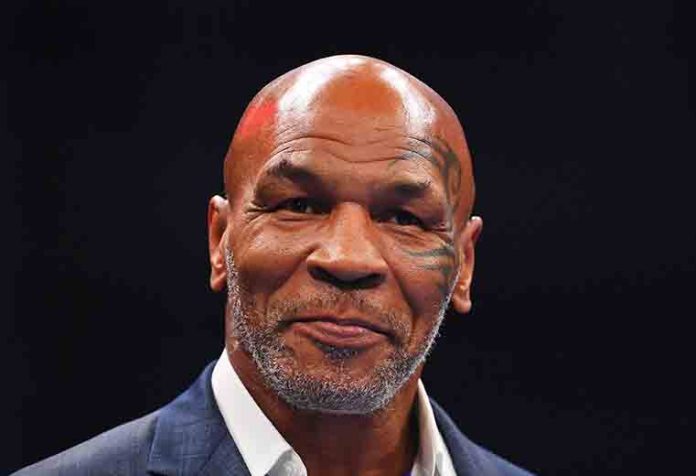During a night that was supposed to be all about the latest bout featuring Jake Paul, an unforeseen moment quickly shifted the spotlight towards boxing legend Mike Tyson. As Tyson made his way to the ring, the camera caught an unexpected glimpse of Tyson’s bare backside, leading to a flurry of reactions from fans and commentators alike. Social media exploded with memes and humorous commentary, as many were quick to share their astonishment and amusement at the unintentional exposure. Tyson, known as “Iron Mike,” has long been a figure of fascination, but this unexpected moment added a new chapter to his storied legacy.
The aftershock of the incident rippled through the event, with fans and analysts debating whether this moment overshadowed the actual fight. Conversations popped up everywhere, from Twitter threads to late-night talk show monologues, featuring remarks such as:
- “Only Mike Tyson could turn a fight night into a comedy show!”
- “Talk about a slip-up—never thought we’d be talking about his backside instead of his knockout power!”
- “The fight might be scripted but that butt was all too real!”
As Tyson continues to make appearances in different capacities within the sport, this particular moment serves as a reminder of the unpredictable nature of live events and the personalities involved in them.
Examining the Impact of Tysons Slip on Social Media Buzz and Fight Culture
The recent incident involving Mike Tyson, where his bare butt captured the spotlight during Jake Paul’s fight, has ignited a flurry of activity across social media platforms, showcasing the unpredictable nature of modern fight culture. As the clip of the moment went viral, it not only overshadowed the primary event but also raised discussions about the evolving standards of decorum among fighters and the implications of personal branding in a sport that often blurs the lines between athleticism and entertainment. Fans and critics alike took to platforms such as Twitter and Instagram, sharing memes and commentary that transformed a simple wardrobe mishap into a sensational topic for debate. The incident serves as a poignant reminder of how quickly public perception can shift and how minor slip-ups can snowball into defining moments in a fighter’s career. Social media users are analyzing Tyson’s blunder in various ways, framing it in contexts that extend beyond the fight itself. Some notable themes include:
- Authenticity vs. Performance: The incident rekindled conversations about the authenticity of fighters, sparking debates on whether such moments humanize them or undermine their professional image.
- Memes and Virality: The power of meme culture has turned the slip into a viral sensation, with creators leveraging humor to dissect not just the slip-up but the entire fight.
- Cultural Shifts: As fight culture continues to evolve, Tyson’s slip exemplifies the shifting boundaries of acceptable behavior in a sport often associated with grit and toughness.
Collectively, these discussions illustrate the profound impact of social media on the narratives that surround fighters and how they define their legacies in an increasingly digital landscape.
Reactions and Reflections: How Tysons Wardrobe Malfunction Shaped Viewer Engagement
The unexpected wardrobe malfunction experienced by Mike Tyson during the recent fight against Jake Paul ignited a flurry of reactions across social media and traditional news platforms alike. While the spectacle itself may have been unintentional, it sparked an array of memes, gifs, and discussion threads, capturing the attention of fans and casual viewers. Highlights from the incident included:
- Chatroom banter, with many viewers immediately commenting on Tyson’s reaction.
- Rapid-fire memes that transformed the moment into a humorous social media phenomenon.
- Debates about respect, dignity, and the nature of boxing as entertainment.
Beyond the initial shock and laughter, the incident prompted deeper reflections on viewer engagement in combat sports. The event unveiled both the vulnerabilities and the humanity of athletes like Tyson, showcasing that even legends are not immune to mishaps. Key takeaways from audience interactions highlighted:
- The power of relatable content in breaking down the perceived barriers between superstars and fans.
- Heightened engagement resulting from shared experiences, with viewers feeling a sense of unity and recognition.
- A shift in perspective that frames these moments not merely as embarrassing, but as authentic slices of life that resonate with a broader audience.

The Fine Line Between Performance and Personal Image in Modern Boxing Events
In a sport where bravado and visual spectacle reign supreme, the wrestling of personal image and athletic performance often defines an athlete’s marketability. The recent Jake Paul vs. Mike Tyson event brought this dynamic to the forefront, particularly when social media was ablaze with images of Tyson’s bare butt, caught in a moment that was both unexpected and revealing. Observers can’t help but wonder how such a visceral image intertwines with the carefully curated personas that boxers strive to maintain. While Tyson himself has built a legacy that combines ferocity and vulnerability, this incident raises questions about the nature of branding in sport.
As fans debate the implications of Tyson’s wardrobe malfunction, discussions also emerge regarding the balance between the athlete’s raw performance and the fabricated persona that often precedes them into the ring. In modern boxing, where lavish entrances and entertaining narratives are as critical as the punches thrown, the incident serves as a reminder that a fighter’s image can be as unpredictable as the sport itself. Promoters and athletes alike must navigate this precarious balance, weighing the thin line between showing real emotion and maintaining a polished facade. Whether it is the bold choices of Jake Paul or the legacy of Mike Tyson, the performance and personal image will continue to be an intricate tango on the boxing stage.
